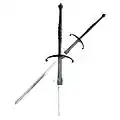Flame-bladed sword
A flame-bladed sword or wave-bladed sword has a characteristically undulating style of blade. The wave in the blade is often considered to contribute a flame-like quality to the appearance of a sword. The design of the blade is purely decorative. The two most common flame-bladed swords are rapiers or Zweihänders, although there have been other sword types with flame-blades.
Flambard, flammard, and Flammenschwert
The two-handed flame-bladed sword is called by the German Flammenschwert (literally "flame sword"). These swords are very similar to two-handed sword or Zweihänder, the only difference being the blade. Like other Zweihänders they were used during the 16th century by the Landsknechts, well-trained and experienced swordsmen, who were called Doppelsöldner (double mercenary) because they received double pay.
Flamberge
The flamberge is an undulating blade that is found on both long blades and rapiers. When parrying with such a sword, unpleasant vibrations may be transmitted into the attacker's blade. These vibrations cause the blades to slow contact with each other because additional friction is encountered with each wave. The term flamberge was misapplied to refer to two-handed swords and was used later to refer to cup hilt rapiers with a straight blade. The flamberge's undulating blade is no more effective at cutting than a straight one.[1]
Gallery
 A Flammenschwert. This is a two-handed sword featuring an exceptionally long blade and hilt, a wide crossguard, and a ricasso with a pair of parrying hooks
A Flammenschwert. This is a two-handed sword featuring an exceptionally long blade and hilt, a wide crossguard, and a ricasso with a pair of parrying hooks A one-handed sword of the flamberge type
A one-handed sword of the flamberge type A flame-bladed swept hilt side-sword (right)
A flame-bladed swept hilt side-sword (right)
See also
- Colichemarde blade — a type of robust smallsword blade
- Flaming sword (mythology) — figurative flaming swords in mythology
- Kris — a Southeast Asian bladed weapon with a similar flame-shaped blade
- Snake Weapons that are trained in Snake Kung Fu: Snake Sword, Snake Spear, Snake Tongue Spear, Snake Crescent Spear, Snake Halberd and Snake Fork (Dragon Palpus/Dragon Mustache Fork[2]) and Raven Spear are Chinese weapons with similar flame-shaped blade[3][4]
References
- "Definitions & Study Terminology: Medieval & Renaissance Sword Forms and Companion Implements". The Association for Renaissance Martial Arts (ARMA). Retrieved 27 July 2018.
- https://imperialcombatarts.com/military-forks.html
- https://imperialcombatarts.com/spear-training--265383068321433.html
- https://imperialcombatarts.com/halberds--pole-axes--25096.html
External links
 Media related to Flame-bladed swords at Wikimedia Commons
Media related to Flame-bladed swords at Wikimedia Commons
